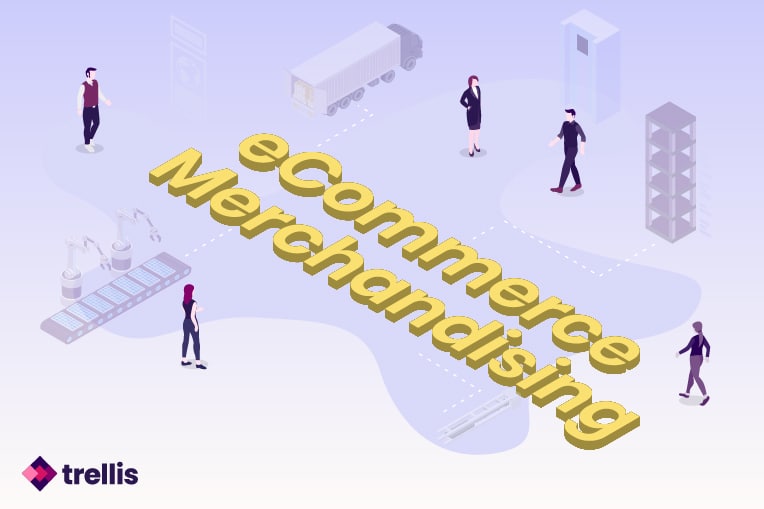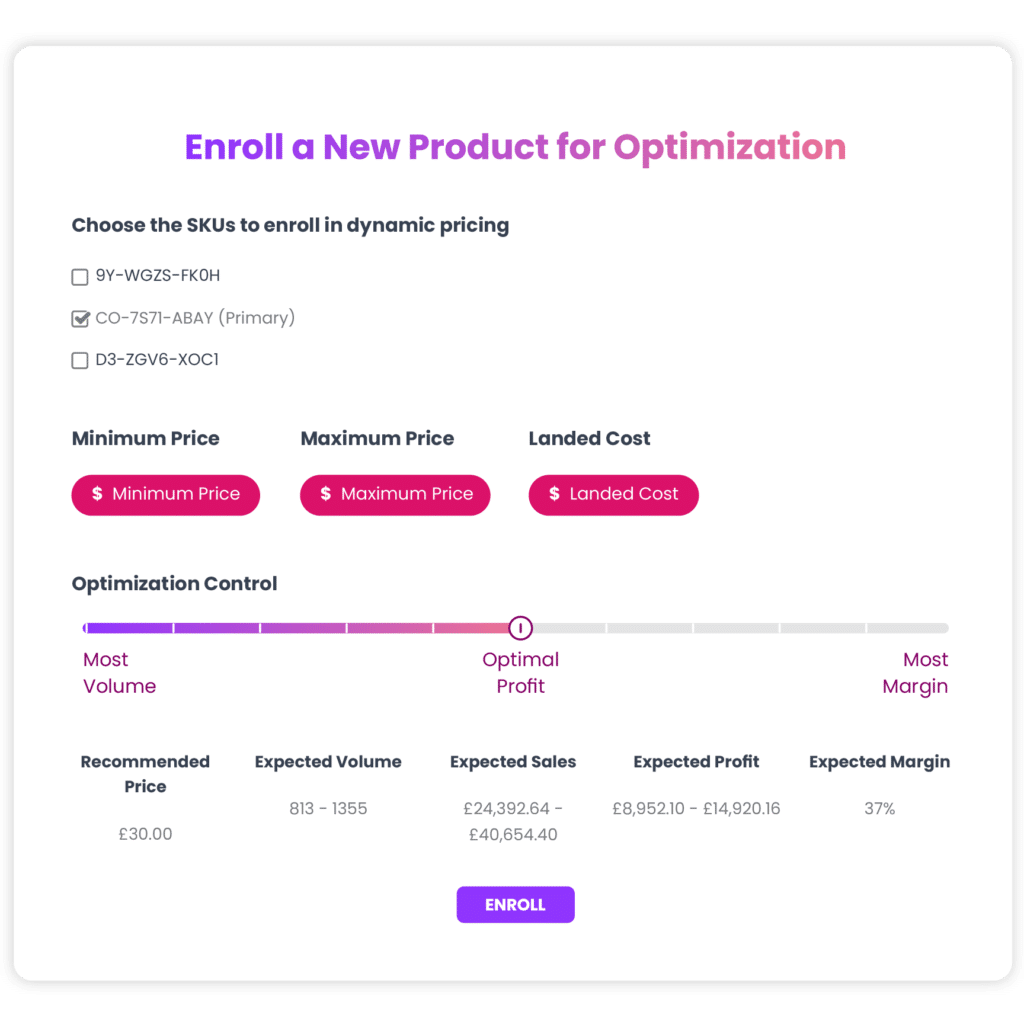Optimizing the same variables over and over again is stagnating eCommerce stores. Many respond by taking on more, making eCommerce Merchandising increasingly complex.
In this ultimate introduction, we establish a framework to help understand eCommerce Merchandising using the tried and tested 4Ps of marketing.
We provide the steps to gain a line of sight on your 4Ps, merchandising workflows, and technology to combine your efforts toward your ultimate goal.
We start by applying the 4Ps of marketing to an eCommerce landscape creating the 4Ps of eCommerce merchandising:
- Placement of Advertising,
- Pricing,
- Promotions, and
- Product content.
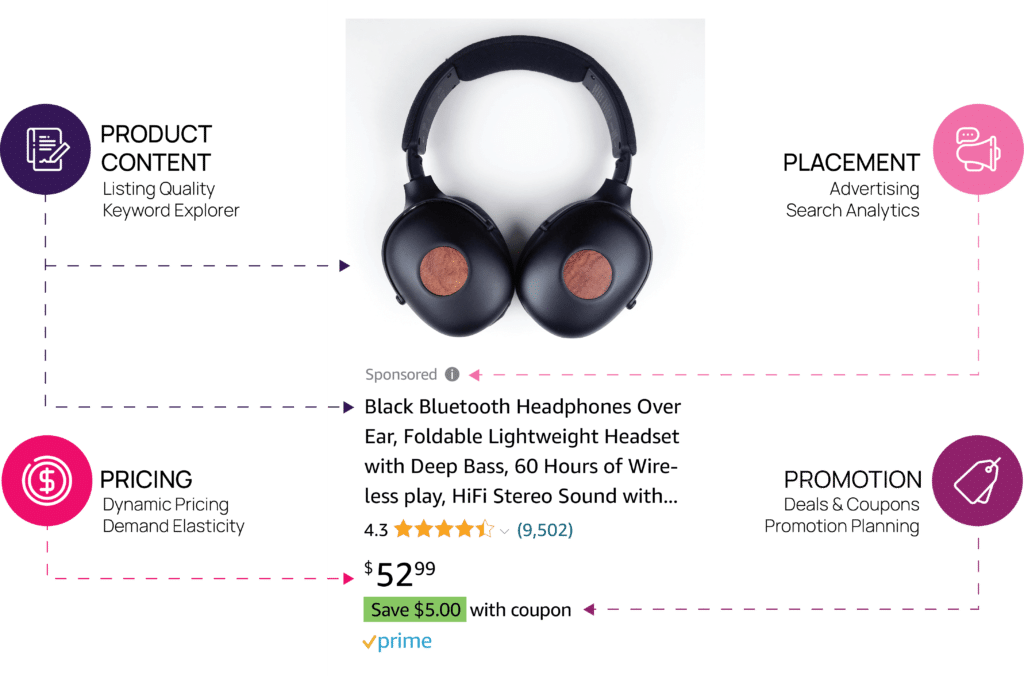
By using the Ps of marketing, we establish workflows and processes to leverage today. Meet needs like: maximizing best sellers, clearing out products, launching new ones, and much more.
Why adapting to eCommerce merchandising matters?
Today, most marketing teams focus their marketing mix on the placement of advertising. They optimize their targeting, choose the right marketplaces, and advertise at the right times. While the options are endless, a very small fraction of them are fruitful.
Teams dedicate energy and resources to find what drives business objectives. They solve for different metrics like CTR, conversion rate, ACoS, customer LTV, and more. The advertising cycle grows as marketing teams nurture brand loyalty and growth.
On websites like Amazon, this is becoming increasingly difficult. Reports suggest that Amazon takes almost 50% of brands’ Gross Merchandising Value (GMV). Fees and advertising costs are driving marketers to optimize in different, more efficient ways.
Marketers are focusing more on merchandising rather than advertising. This includes optimization of all 4Ps to improve ACoS, to increase their overall profitability, and to grow their GMV.
Merchandising experts differentiate with pricing, promotions, and content to pry away marketshare. They understand things like:
- Goldilocks pricing,
- Turnover from promotions,
- Converting keywords, and
- Much more
By finding things like your Goldilocks price, you can gain an edge. Understanding this type of detail about your products is the result of thoughtful testing which means many competitors haven’t done it.
This is especially valuable on places like Amazon where the knee-jerk reaction of sellers is to lower prices. Finding a middle ground often leads to higher profits as small margins on top of your cost of goods doesn’t equal a huge sum.
These higher profits can snowball into more growth. Leverage more cash in hand to purchase assets, more ad space, or expand operations. Breach different revenue groups and become a leader yourself.
What are the 4Ps of eCommerce Merchandising?
The 4Ps of eCommerce Merchandising are built on the 4Ps of the marketing mix. They include Placement of Advertising, Pricing, Promotions, and Product Content. These highlight an important aspect of selling on:
- Amazon,
- Walmart,
- Direct-to-consumer (D2C) ecommerce, and
- Other eCommerce landscapes.
Placement of Advertising
Traditionally, placement in a marketing strategy includes both time and place to reach a target market. In physical retail, it might be the store location of a coffee shop or the shelf location of a brand of chips. Theaters leverage their service during certain times while we only see eggnog on shelves during a certain time of year.
Both time and place relate to the fundamentals of selling and are levers companies pull to make things more accessible when they need to be. The end result: playing movies when people are available and effective sales of egg nog when it’s in high demand.
Like in physical retail, the placement of advertising in eCommerce is about accessibility. Key factors in fuelling this accessibility are advertising placement whether it is through keywords, different marketplaces, or across marketing channels. The goal is to put products front and center.
While many factors go into understanding the placement of advertising some of the most important are:
- Marketplace and marketing channels,
- Keywords,
- Bids,
- Ad types,
- Other types of targeting like remarketing and contextual targeting, and,
- Time of day, time of month, and seasonality for advertisements.
All play a factor in attaining the right attention for your product. Yet, being in the right place at the right time isn’t the only factor for customers. Capable and discerning humans usually don’t pick the first product in front of them, and look at other factors such as product content to make their decisions.
Product Content
Product Content is a representation of a Product from the 4Ps of Marketing. While the physical product you sell is still as important as it always has been, when it comes to effective merchandising it is important to think about how and what you communicate about your product.
In a world like Amazon, noticeable product differentiation is hard to come by. The competition is fierce when you’re next to limitless other brands. It is vital to optimize product content to match the expectations of customers.
Making the sale is dependent on:
- Quickly establishing your brand and its benefits,
- Highlighting a few unique features in your title and A+ content,
- Maximizing the number of positive reviews, and
- Refining the aesthetics of the listing through images and by meeting Amazon’s best practices.
Done right, you should see organic reach while also increasing the effectiveness of the Placement of Ads through better conversion rates. Optimizing these 2Ps makes up a large part of what advertisers do today while they neglect pricing.
Price
Pricing is a huge driver of purchasing decisions, 80% of shoppers say that they compare prices before purchasing a product.
Before in physical retail, customers had limited options. Customers were more likely to make purchases based on convenience or brand loyalty.
In a competitive marketplace like Amazon, customers have easy access to a wide variety of products, and it’s easy to compare prices between different sellers before making a purchase decision.
If a seller’s price is too high, they are likely to lose potential customers. If a seller’s price is too low, they risk losing profit and potential revenue. There’s an important balancing act that you need to take as a seller on Amazon to find your “Goldilocks pricing.” You find this through rigorous testing using price modeling and automation software like ours.
No matter how you do it, good eCommerce merchandising requires diligent price changes across your organization.
Promotions
Promotions provide a similar effect to what a combination of good prices and advertising does for sales with some hidden risks.
Opportunities
Promotions allow you to engage in shopping seasons, help you move extra inventory, and create cash flow.
Instead of lowering your prices, promotions also come with the added benefit of drawing attention to your product where low prices easily blend in and suggest a low-quality product.
If done right, promotions draw in new users like advertising but without a fluctuation in cost per sale. A discount of 10% is always going to cost you 10% of the product’s original price.
This is unlike advertising where ad spend could be any percentage of the products’ price. This means promotions give you exposure and increase conversions like advertising but keep the cost of the sale consistent.
With this predetermined cost, merchandising specialists use promotions for predictable turnover. By modeling your past promotions, see how much a certain discount moves products. This means that if you need to move inventory or generate revenue, run a discount for as long as your model suggests. This predictability gives you freedom in how you run your business.
Threats
Even with these advantages, it’s important to carefully manage promotions. The first and most manageable problem with discounts is keeping them profitable. Without the right systems, your discounts could bring your price below your fixed costs. Leading you to lose money.
You have to understand discounts’ relationship with your profit margins. If you’re not careful on Amazon, you may get caught accepting a suggested promotion that puts you in the red.
The less manageable threat of promotions to consider is how it may reflect on your brand. If you want to create return customers with promotions you may be disappointed. Psychologically, excessive discounts are known for undermining your products and in major cases your overall brand image.
Customers begin to expect promotions and often wait on a purchase because they expect a discount. This has lasting effects and sometimes has unknown consequences if you’re not careful.
Track all 4Ps, your margins, and your brand’s long-term health by adopting an eCommerce merchandising mindset.
Workflows to leverage the 4Ps
4P merchandisers need to build out processes to ensure that their analysis is thorough and actionable.
4P Optimization
ECommerce Merchandising specialists do consistent and structured analysis. They understand their costs, make optimizations to improve sales, and distill opportunities from tests.
Identify Costs

Business leaders define merchandising success by how well they manage costs. How they spend their budget, develop profit and loss statements, and manage KPIs is foundational.
If you’re moving towards an eCommerce Merchandising mindset, keeping track of costs means understanding all the money going out as a result of merchandising activities. These expenses aren’t forgotten on the bottom line and should be a part of any high-level analysis. Some major costs to account for are:
- Ad Spend,
- Deal Fees,
- Discounts,
- Content Costs,
- Software Fees,
- Employee costs,
- Cost of goods, and
- Marketplace costs.
While some expenses wander outside of the scope of eCommerce Merchandising experts. It’s important for marketing teams to recognize what finance teams already know: that doing things like consolidating software or outsourcing work has immediate benefits for your financial health.
If you have oversight of your costs at a marketing level not only are your stakeholders more excited to keep you around but it means that your analyses are going to be more impactful.
Increasing Sales

Limiting costs means very little if you’re not providing results. Results come from effective optimizations across the funnel. Merchandising teams need to know which metrics to solve for: from the number of products all the way to average order value.
Number of Products
If we use the 80/20 rule, we understand that not all products are best-sellers. Though, businesses with more products increase their chances of hitting a major market need. While there are costs associated with growing this way, expanded product lines are one of the biggest indicators that you are leading your category in market share.
Best Seller Rank (BSR)
BSR is an Amazon indicator that customers like your product. Amazon uses this information to improve SEO, reduce ad costs, and augment other sales-generating factors. Focus on producing historical sales volume, it improves efficiency for your entire funnel.
Click-Through Rate
Start with a good first impression with well-placed advertising, strong discounts, competitive prices, and refined titles and images.
Conversion Rate
Optimizing conversion rate is a great place to focus on making the most of expensive traffic. All 4Ps improve conversion rates whether it is through a promotion, communicating your value propositions, providing good value for the price, or ensuring that you are targeting the right keywords.
Average Order Value
Changes in average order values leads to larger profits. Decreases in price lead to a greater number of products sold while slight price increases could lead to over a million dollars in extra revenue.
By leveraging the 4Ps you effectively optimize for sales and generate extra profit.
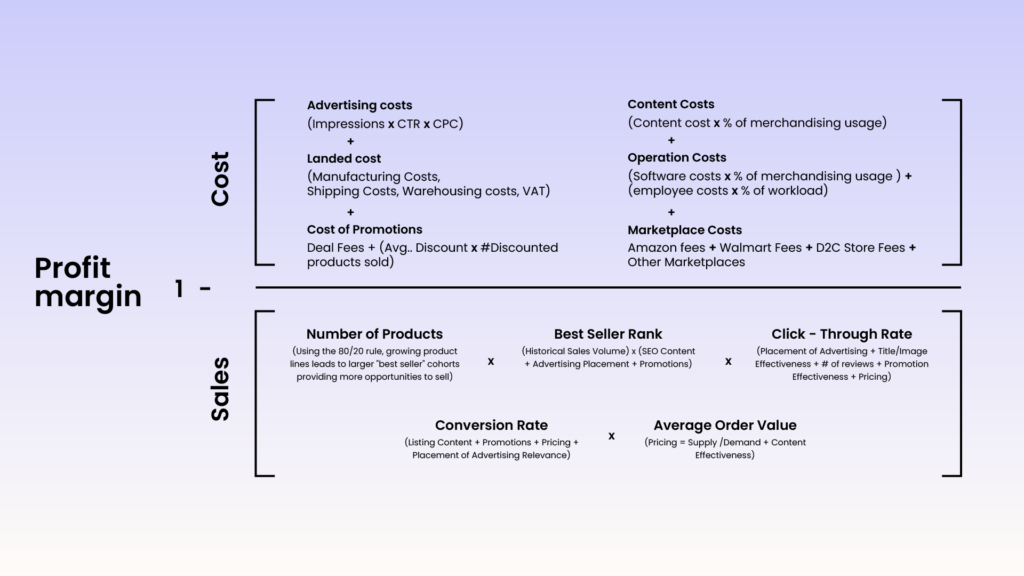
To gain a clear picture of your business’ overall health, divide your costs by your sales metrics. Similar to ACoS, profit margin provides you with a high-level look at how your account, campaigns, products, and 4Ps are faring along the funnel.
See what is profitable by evaluating your sales against your total costs. Having profit margins readily available for all products gives you answers to a range of questions like:
- What should your ACoS be,
- How heavily to discount the product,
- What’s your minimum price, and
- How much should you invest in content for the product?
Segmentation to Identify Opportunities
As you integrate profit margins and their underlying metrics, use your data to identify opportunities. For large sets of data, benchmarking your campaigns helps. Look at all levels of the funnel through CPC, Total Sales, Profit Margins, and Customer Lifetime Value (CLV). Then segment your 4Ps accordingly.
Setting Benchmarks For Product and Account Level Dimensions
Metrics like CPC, Total Sales, and Profit Margins tell you a lot about your account and its products. To identify opportunities, quickly discern which variables perform good, better, and best.
In practice, this means taking your products’ CPCs, Total Sales, and RoMS and evaluating them against different dimensions like:
- Time of day,
- Month to month,
- By product category, and
- Variables in your 4Ps like price, keywords, and discounts.
These benchmarks give you opportunities like times to advertise, months to run promotions, and product categories to focus on.
User Level Benchmarks
Another major component to consider is your customer experience. As opposed to product and account level dimensions, user level dimensions give you insight into your users’ journey. A good way to track your users’ journey is through CLV.
Tracking your users’ CLV gives you insight into how a customer interacts with your brand and what products they keep coming back to. CLV ensures that you are evaluating products accurately.
For example, at a product level, you may see high CTRs and conversion rates for consumables. Without using CLV you may not realize this is due to return customers who are familiar with your brand because of an introductory product.
At a product level, this introductory product has low CTRs and conversion rates because it is doing a lot of heavy lifting in introducing customers to the brand.
Without looking at CLV, you turn off the ads and raise prices for your introductory products to meet certain KPIs. As a result, fewer users enter your pipeline leading to a slowdown in repeat purchases.
Making these connections is important but is difficult in places like Amazon where user data is often hard to find. To ensure that you are evaluating products correctly, it is valuable to have software. It helps to identify your new-to-brand products and which are repeat purchases.
Ways to Segment Your Products
To take action, we use our benchmarks to create segments. There are two ways to do this, either by using an absolute number or a rolling average.
An absolute benchmark is a benchmark that businesses select and stays consistent until objectives change. One use-case of an absolute benchmark is to accelerate growth.
When you first start your campaigns you may set a low-profit margin benchmark of 5%. You know you’re growing and want to increase sales velocity. As a business, you’re happy if you’re just breaking even. You do this because you know that by giving up your profit margins, you’re able to sell a lot more products and use a lot more keywords to generate sales.
Though, as a business meets its growth objectives or you start to run low on cash, you’ll want your advertising to start putting money back into the coffers. With your 5% profit margin benchmark, you may not be. In these cases, you should run your ads based on a rolling average.
Updating your benchmarks based on a rolling average means as you improve your merchandising, your benchmarks update accordingly.
Rolling averages help to improve efficiency as your business learns more about its customers. To keep up, it requires constantly monitored data and a strong sample size.
4P Segmentation
Once you have benchmarks, begin to segment your 4Ps. At a high level this means identifying which prices, promotions, placements, and product content are good for what objectives. For example, a business focusing on profitability may only use keywords with the lowest ACoS, prices that provide healthy profit margins, and product content fixed on improving conversion rates.
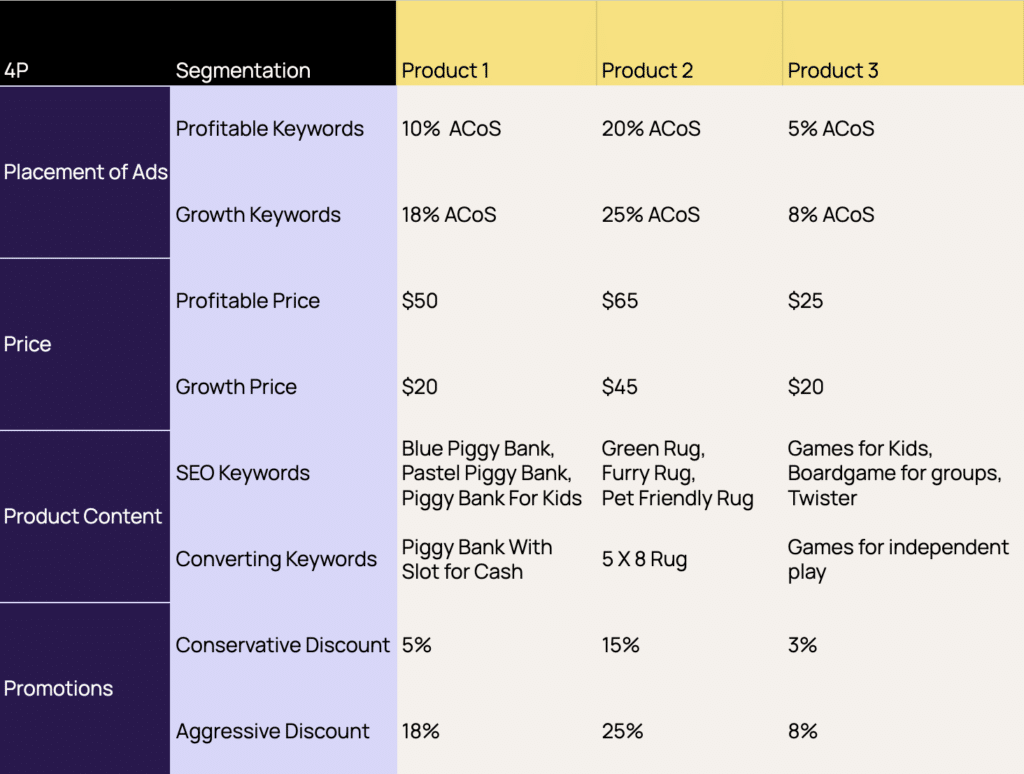
As visible in the table, adjustments on the 4Ps help reach different objectives. Not all Ps can be used the same way for every strategy.
Most times a certain keyword, price, or promotion comes with a trade-off. It’s important to accept this and build processes that work around them.
In a scenario where a business uses its keywords with the best ACoS, the business has to accept that the ads may slow down, only serving on a few niche keywords. Once they look to grow market share, they will adapt the 4P segments they’re using. Increasing their ACoS tolerance and the keywords that are acceptable as a result.
To make this an active part of your workflow, start to create metric based categories for each of your 4Ps across every product.
Want to run a profitable campaign? Take a look at your ads with the best profit margins.
Want to clear some inventory? See what types of promotions sell the most.
Have a trending product that you want to maximize? Use the price that provides the best total sales.
Those who are really keen, segment their 4Ps on a spectrum accounting for gray areas in their objectives.
For example, an organization may have a timeline to move inventory but doesn’t need to get rid of it immediately. In this case, optimizing for profitability may be too slow but optimizing for turnover is too fast. So an organization looking to find a middle ground, might use a spectrum to find their goldilocks zone. Selecting product content, promotion, price, and advertising that fits this middle ground.
Even simple 4P segmentation to begin with helps you to easily adapt your workflows as different situations pop up.
When handling large data sets, using benchmarks to segment your 4Ps is the most effective way to action high-priority opportunities.
Think sifting through all of this data yourself might be challenging? Give Trellis a shot.
Taking Action
Now that you understand how your data and segmentation might be used. How can you build a practical workflow to action the data?
Product Life Cycle Tags
Not every product in your catalog is a best seller. Some products are new while others are overstocked. By giving every product life cycle tags, you start to associate an implied objective with each product. This objective becomes a north star for each 4P.
Some life cycle tags you might want to consider are:
- Best Sellers,
- New product,
- Clearance,
- Low Inventory,
- Overstock,
- Introductory Product, and
- Many more.
Once you have these lifecycle tags along with your 4P segments, combine them to meet certain use-cases.
Combining the 4Ps Use Cases
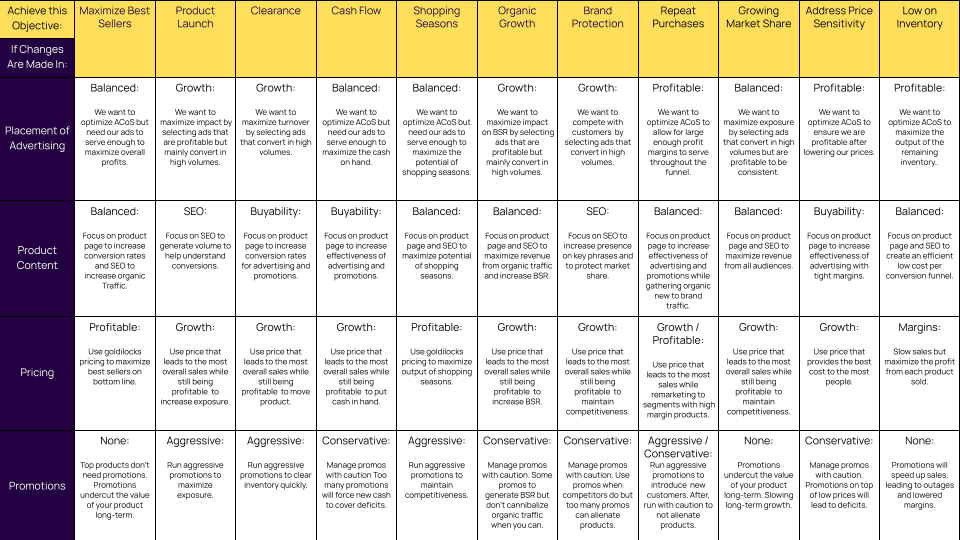
By associating an objective with each product, you leverage the underlying Ps in a way that helps you reach your objective most effectively.
Best sellers may perform well when using a balanced set of keywords alongside conversion focused product content and goldilocks pricing.
Best sellers during shopping seasons may need a similar approach but with more aggressive promotions to help stand out.
Ultimately, by using an eCommerce merchandising workflow you are able to sell your products with a much more nuanced approach. Instead of selecting a range of keywords and picking the promotions suggested by your marketplaces, use your 4P segmentation to select the right variables to maximize your desired outcome, at a moment’s notice.
Leveraging Different Channels
The value of building your business on a 4P framework is that it can be readjusted everywhere with a few changes. Not only helping you streamline your workflows within each marketplace but across all channels.
Amazon eCommerce Merchandising
Amazon is arguably the most lucrative marketplace for eCommerce. They provide a large cohort of high-intent customers for almost any product.
An eCommerce merchandising mindset is important to track variables like price and product SEO. Factors that are important to watch in the competitive environment.
Merchandising experts are valuable to help manage promotions. They build good frameworks that set clear profit margins for your products to avoid accepting an unprofitable recommended promotion.
Optimizing placement of advertising is common practice on Amazon. A huge amount of their result pages contain sponsored product ads. ECommerce Merchandising workflows ensure that you have a method to run them profitably.
Walmart eCommerce Merchandising
Walmart is up and coming in eCommerce. Many of the features Amazon provides, Walmart is rolling out. Leveraging the same tactics on Walmart should give you similar success with a few exceptions.
There is an opportunity to take advantage of Walmart’s growth phase. Segmenting and leveraging your products is a bit different on Walmart if you want to take advantage.
By accepting higher ACoS from your Walmart Keywords, you will build an early presence in the market.
You may find that you need lower prices to fit into the budget-friendly retailer.
Product Content SEO may be simpler to achieve as there are fewer competitors
Direct to Consumer (D2C) eCommerce Merchandising
D2C merchandising requires the most thorough merchandising strategy compared to other channels. It takes a huge amount of awareness to manage, necessitating workflows to manage properly.
Direct-to-consumer eCommerce stores leverage numerous channels making advertising placement varied and complex. Building workflows for them requires strong frameworks to keep it connected.
However, the principles stay the same. Gain a line of sight on all of your 4Ps, the associated costs, your sales, and your benchmarks. With a structured framework, fully leverage the freedom of D2C marketing.
Using technology to support merchandising
You may need help to maintain 4Ps instead of one. Some AI and automation will identify costs across your merchandise, and manage the entire workflow. Simplifying eCommerce merchandising.
The emergence of automation, AI, and machine learning
Brands are adapting to reach more customers as barriers become more difficult to overcome. Advertising automation software is embedded in mainstream marketing practices, Chat GPT is supporting creatives, and ML is creating better spreadsheets.
In 2019, 37% of organizations said that they used AI in the workplace. A lot has changed since then including a Pandemic, an eCommerce boom, and concerning inflation growth. Problems which have accentuated the need for automated labor whether we like it or not. One reason why 63% of companies say that they plan to increase or maintain AI spending in 2023.
For eCommerce merchandisers looking to stay competitive, they need to spend a lot more time on their merchandising. Time they don’t have unless they want to work nights and weekends.
Should you be skeptical of AI
With a clear eCommerce merchandising framework automation thrives. AI and ML work well when they are given rules to follow like it’s a game. Just ask Deep Blue who defeated Chess GrandMaster Gary Kasparov in the late 90s.
Finding software that executes the framework we’ve laid out in front of you is not hard. The 4Ps are using the same principles that humans should. AI understands the data, segments it effectively, and actions the opportunities with little human help.
As humans grow worried at the loss of control, merchandising experts gain control by embracing AI powered systems. They now have the time to manage a much wider scope of eCommerce. To bring chess back into the conversation: you’re no longer a pawn instead you control the entire board.
How automation helps
You’re spending too much time on your eCommerce merchandising if your manual workflow includes:
- Hourly price changes,
- Real-time keyword updates, or
- Calculating turnover for promotions.
Correcting these is a few of the ways eCommerce Merchandising software helps.
Save time to focus on the bigger picture
Merchandising software helps you focus on strategy and creative discussions. Automation allows you to take more directional steps towards your goals rather than maintaining the status quo.
To make decisions in a split second, data is uploaded right into algorithms and built-in confidence calculators. Even optimizing a medium-sized business or product catalog would take longer than learning to automate and reconfigure your workflows.
Market a product with a lot more nuance
Because time is limited, humans tend to find a lot of shortcuts in their workflows. Usually, we deprioritize small alterations and things with little impact in favor of big-picture adjustments. Automation gives users this freedom without sacrificing the end result of those big pivots.
You’re wasting time planning promotions, uploading your content, and deciding on your prices if you don’t have something like the right keywords. Many small tedious tasks done poorly make a noticeable impact on the big picture. Automation ensures that the time you spend isn’t done in vain.
The right 4P automation ensures that every detail talked about in this blog is optimized based on your objective.
Free to grow your organization and sales
Growth is largely contingent on your business’s ability to optimize your merchandising. If your 4Ps are left untouched, you are unlikely to leverage new opportunities. Automation helps by understanding your objectives and using 4P segments to action the right solution.
While managing results, activating large pivots is difficult without assigning someone a significant workload. The ability to grow and launch a product catalog size is a huge determinant of a brands market share on Amazon. It’s difficult to do both and merchandising teams need to be able to keep up.
If there is significant lag between product R&D, and marketing then there is less chance that you leverage the initial research or ideas that inspired the product in the first place in time.
This leads to major downsides in a world where people are after the new thing. If you don’t have automation to help streamline the labor and decision-making process then it is hard to stay ahead of the pack.
Being able to effectively grow your team is also important to keep up with a business’s growth. To do so, agencies and large eCommerce stores require standardized operating procedures (SOPs). Automated systems often help keep those procedures simple and streamlined.
Having systems that are managed by low-skilled workers means you aren’t relying on a headhunter or a long hiring process to fill your roles. This keeps you focused on growing results, not your team.
With the emergence of AI, merchandisers no longer need to learn complicated frameworks. Instead, growth is streamlined and automated.
Trellis
Our 4P eCommerce merchandising software for Amazon sellers is the first of its kind. Trellis uses the exact framework discussed in this guide to manage your 4Ps.
We’ve built specific workflows to ensure new products, best sellers, and overstocked inventory is never forgotten. Start automating and streamlining your Amazon 4Ps and Walmart Advertising campaigns in one place.



